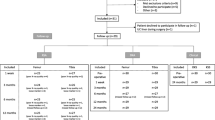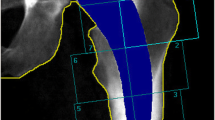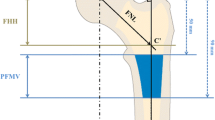Abstract
Introduction
To study the load distribution of the thrust plate hip prosthesis (TPP, Sulzer Medica, Baar, Switzerland) on femoral bone, a TPP insertion group and intramedullary cemented stem insertion group were prepared with the use of embalmed femoral anatomic specimens, and strain on the femoral bone induced by loading was measured.
Materials and methods
Bone scintigraphy was performed in 26 joints which underwent total hip arthroplasty with the use of TPP, to enable quantitative evaluation of postoperative remodeling of the bone.
Results
In the TPP insertion group, the strain was almost equivalent to that in the untreated femoral control group. On the other hand, compared with the control group and TPP insertion group, strain in the proximal portion of the femoral bone (medial side of the femoral neck) was significantly smaller in the cemented stem group (control group versus cemented stem insertion group, p=0.0062; cemented stem insertion group versus TPP 130° insertion group, p=0.0005; cemented stem insertion group versus TPP 140° insertion group, p=0.0031). Bone scintigrams revealed decreased uptake at 12 weeks after operation compared with 6 weeks after operation, indicating that TPP allows earlier implant stabilization than the conventional stem.
Conclusion
Compared with the conventional stem, TPP is a prosthesis that can perform physiological load transmission.






Similar content being viewed by others
References
D’ Antonio JA et al (1997) Hydroxyapatite coated implants. Total hip arthroplasty in the young patient and patients with avascular necrosis. Clin Orthop 344:124–138
Bereiter H, Burgi M, Schenk R (1997) Finite element investigations of the proximal femur after implantation of the thrust plate prosthesis compared with findings in a post-mortem histological specimen and in radiological follow-up examinations. In: Huggler AH., Jacob HAC (eds) The thrust plate hip prosthesis. Springer, Berlin Heidelberg New York, pp 48–62
Bereiter H, Huggler AH, Jacob HAC (1991) The thrust plate prosthesis (TPP). A new concept in hip prosthesis design. Eight years of clinical experience. Orthop Rel Sci 2:191–202
Bobyn JD, Mortimer ES, Glassman AH (1992) Producing and avoiding stress shielding. Laboratory and clinical observations of noncemented total hip arthroplasty. Clin Orthop 274:79–95
Caniggia M, Burroni L (1991) Bone scanning in the evaluation of total hip replacement. Ital J Orthop Traumatol 17:375–379
Diegel PD, Daniel AU, Dunn HK (1989) Initial effect of collarless stem stiffness on femoral bone strain. J Arthroplasty 4:173–178
Djerf K, Gillquist J (1987) Calcar unloading after hip replacement: a cadaver study of femoral stem designs. Acta Orthop Scand 58:97–103
Dorr LD, Kane TJ, Conaty JP (1994) Long-term results of cemented total hip arthroplasty in patients 45 years old or younger. A 16-year follow-up study. J Arthroplasty 9:453–456
Engh CA, Bobyn JD, Glassman AH (1987) Porous-coated hip replacement. The factors governing bone ingrowth, stress shielding, and clinical results. J Bone Joint Surg Br 69:45–55
Fink B et al (2000) Short- and medium-term results of the thrust plate prosthesis in patients with polyarthritis. Arch Orthop Trauma Surg 120:294–298
Hugh P, Chandler HP, Reinneck FT (1981) Total hip replacement in patients younger than thirty years old. A five-year follow-up study. J Bone Joint Surg Am 63:1426–1434
Huggler AH (1997) The thrust plate prosthesis. A new experience in hip surgery. In: Huggler AH, Jacob HAC (eds) The thrust plate hip prosthesis. Springer, Berlin Heidelberg New York, pp 1–24
Huiskes R, Weinans H, Rietbergen BV (1992) The relationship between stress shielding and bone resorption around total hip stems and the effects of flexible materials. Clin Orthop 274:124–134
Jacob HAC (1997) Biomechanical principles and design details of the thrust plate prosthesis. In: Huggler AH, Jacob HAC (eds) The thrust plate hip prosthesis. Springer, Berlin Heidelberg New York, pp 25–47
Jacob HAC, Huggler AH (1980) An investigation into biomechanical causes of prosthesis stem loosening within the proximal end of the human femur. J Biomech 13:159–173
Maniar RN, Todd RC, Robinson S (1997) Uptake of 99mTc-MDP after uncemented hip arthroplasty. J Bone Joint Surg Br 79:123–128
Michael A, Mont MA, David S (1995) Non-traumatic avascular necrosis of the femoral head. J Bone Joint Surg Am 77:459–474
Oh I, Harris WH (1978) Proximal strain distribution in the loaded femur. an in vitro comparison of the distribution in the intact femur and after insertion of different hip-replacement femoral components. J Bone Joint Surg Am 60:75–85
Saito S et al (1989) Long-term results of total hip arthroplasty for osteonecrosis of the femoral head. a comparison with osteoarthritis. Clin Orthop 244:198–207
Salvati EA, Cornell CN (1988) Long-term follow-up of total hip replacement in patients with avascular necrosis. Basset III F (ed) AAOS Instructional Course Lectures, Vol 37. The American Academy of Orthopaedic Surgeons, Park Ridge, pp 67–73
Suh KT, Lee CB, Kim IJ (2001) Natural progress of a bone scan after cementless hydroxyapatite-coated total hip arthroplasty. Clin Orthop 389:134–142
Author information
Authors and Affiliations
Corresponding author
Rights and permissions
About this article
Cite this article
Goto, T., Yasunaga, Y., Takahashi, K. et al. Biomechanical analysis and quantitative analysis of bone scintigraphy on thrust plate hip prosthesis. Arch Orthop Trauma Surg 124, 357–362 (2004). https://doi.org/10.1007/s00402-004-0650-0
Received:
Published:
Issue Date:
DOI: https://doi.org/10.1007/s00402-004-0650-0




